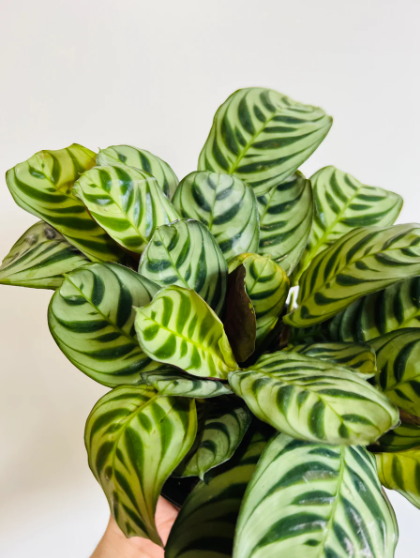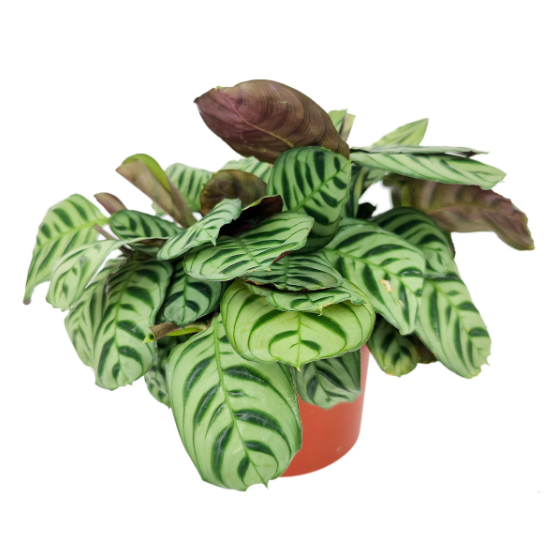Calathea Burle Marx, scientifically known as Goeppertia burle-marxii, is a beautiful houseplant that has captivated plant enthusiasts with its stunning foliage and unique patterns. Originating from the tropical rainforests of Brazil, this plant requires specific care to thrive indoors. In this comprehensive guide, we will delve deeper into the captivating characteristics of Calathea Burle Marx, explore its ideal growing conditions, discuss maintenance and care tips, and address common troubleshooting issues to help you successfully cultivate and enjoy this remarkable plant.
The Beauty of Calathea Burle Marx:
Foliage:
Goeppertia burle-marxii features large, oval-shaped leaves with vibrant patterns ranging from bold stripes to intricate veining. The foliage color palette spans from deep green to shades of purple, adding a touch of elegance and visual interest to any space.
Size and Growth:
This plant typically reaches a height of around 2 feet (60 centimeters) and forms a dense clump of foliage. Its compact size suits various indoor settings, from small apartments to spacious living rooms.

Ideal Growing Conditions:
Light Requirements:
Calathea Burle Marx thrives in medium to bright indirect light. While it appreciates some exposure to natural light, avoid placing it in direct sunlight as it can scorch the leaves. East-facing or north-facing windows are ideal spots to provide the plant with the right amount of light.
Temperature and Humidity:
Maintain a temperature range of 65°F to 80°F (18°C to 27°C) for optimal growth. Protect the plant from cold drafts and avoid heaters or air conditioning vents. Calathea Burle Marx thrives in high-humidity environments, ideally between 50% to 60%. Consider using a humidifier or placing the plant on a tray with water and pebbles to increase humidity levels.
Soil and Potting:
Use well-draining soil that retains moisture without becoming waterlogged. A blend of equal parts of peat moss, perlite, and potting soil creates an ideal growing medium. Ensure the pot has drainage holes to prevent water accumulation.
Watering and Fertilization:
Watering:
Maintaining proper watering practices is crucial for the health of Calathea Burle Marx. Keep the soil consistently moist but not saturated. Water the plant when the top inch of the soil feels slightly dry. Avoid allowing the soil to dry out completely or become waterlogged. Use room temperature water to avoid shocking the plant.
Fertilization:
Feed Calathea Burle Marx with a balanced, water-soluble fertilizer diluted to half the recommended strength. Apply the fertilizer every two to four weeks during the growing season (spring and summer). Reduce or suspend fertilization during the plant’s dormant period (fall and winter).
Maintenance and Care:
Pruning and Grooming:
Regular pruning helps maintain the plant’s shape and overall health. Trim any brown or yellowing leaves, which are likely damaged or dying. Gently wipe the leaves with a damp cloth to remove dust and enhance their appearance.
Propagation:
Calathea Burle Marx can be propagated through division during repotting. Carefully separate the plant into smaller clumps, ensuring each division has several stems and healthy roots. Plant the divisions in separate pots with fresh potting soil, and provide the same care as mature plants.
Pest Management:
Monitor your Calathea Burle Marx for common pests like spider mites, mealybugs, and aphids. Treat them with an appropriate organic insecticidal soap or neem oil solution if detected. Regularly inspect the undersides of leaves and isolate infected plants to prevent further infestation.

Common Problems, Signs, and Solutions:
Leaf Browning and Edges Crisping
Signs: If you notice brown patches or crispy edges on your Calathea Burle Marx leaves, it indicates that the plant is experiencing low humidity or inadequate watering.
Solution:
- Increase Humidity: Place a humidifier near the plant or use a pebble tray filled with water to create a humid microclimate. Grouping plants can also help create a humid environment.
- Mist the Leaves: Regularly mist the leaves with water to increase humidity and prevent them from drying out.
- Adjust Watering: Ensure the plant is receiving adequate moisture. Water thoroughly, allowing water to drain out the pot’s drainage holes, but avoid overwatering. Check the soil’s moisture level regularly and adjust the watering frequency accordingly.
Leaf Curling
Signs: If the leaves of your Calathea Burle Marx are curling inward or folding, it indicates low humidity, inadequate watering, or exposure to temperature extremes.
Solution:
- Increase Humidity: Boost humidity levels around the plant using a humidifier or placing a tray with water and pebbles nearby. You can also mist the leaves regularly to increase humidity.
- Adjust Watering:
- Ensure the soil is consistently moist but not soggy.
- Water the plant when the top inch of the soil feels slightly dry.
- Avoid letting the soil dry out completely between waterings.
- Protect from Temperature Extremes: Calathea Burle Marx prefers temperatures between 65°F to 80°F (18°C to 27°C). Keep the plant away from cold drafts or direct heating or cooling vents exposure.
Yellowing Leaves
Signs: Yellowing leaves on your Goeppertia burle-marxii can indicate various issues, including overwatering, underwatering, or exposure to cold drafts.
Solution:
- Adjust Watering:
- Evaluate your watering routine.
- Ensure the plant is not in excess water and the soil is well-draining.
- Water the plant when the top inch of soil is slightly dry.
- Monitor Drainage: Check if the pot has proper drainage holes and that excess water can escape. Standing water can lead to root rot and yellowing leaves.
- Protect from Cold Drafts: Keep the plant away from cold drafts or sudden temperature changes. Calathea Burle Marx prefers a stable, warm environment.
Pest Infestation
Signs: Common pests that can infest Goeppertia burle-marxii include spider mites, mealybugs, and aphids. Signs of infestation include webbing, sticky residue, tiny crawling insects, or distorted leaves.
Solution:
- Identify the Pest: Examine the plant closely to identify the specific pest. Different pests may require other treatment methods.
- Isolate the Plant: If the infestation is severe, isolate the affected plant to prevent the pests from spreading to other plants.
- Use Organic Pest Control: Treat the pests with organic insecticidal soap or neem oil. Follow the instructions on the product label for proper application.
- Regularly Monitor and Clean: Inspect your plants for any signs of pest resurgence. Wipe the leaves with a damp cloth to remove dust and discourage pests from settling.
Addressing these common problems and taking appropriate measures ensures that your Calathea Burle Marx remains healthy, vibrant, and a stunning addition to your indoor green space.

Conclusion:
Calathea Burle Marx is a beautiful plant that brings beauty and sophistication to indoor spaces. By providing the right growing conditions, including appropriate lighting, temperature, humidity, and diligent watering, you can ensure the health and vibrancy of this remarkable plant. Regular maintenance, such as pruning, grooming, and pest management, will help sustain its vitality. Embrace the allure of Calathea Burle Marx and create a lush oasis in your home, showcasing the magnificence of nature’s artwork. Read article about Variegated Neon Pothos and Causes Of Monstera Dripping Water in Avi Hoffman Garden.
FAQ
Calathea Burle Marx requires consistent but moderate watering. It’s crucial to keep the soil consistently moist but not soggy. Water the plant when the top inch of the soil feels slightly dry. Depending on your home’s temperature, humidity, and specific conditions, you may need to water your Goeppertia burle-marxii approximately once or twice a week. However, adjusting the watering frequency based on the plant’s needs is essential. Always check the soil’s moisture level before watering to ensure you’re providing adequate moisture without overwatering.
Calathea Burle Marx is considered mildly toxic. While it is not highly harmful to humans or pets, it contains compounds that can cause mild gastrointestinal discomfort if ingested in large quantities. Keeping the plant out of reach of children and pets is essential to prevent accidental ingestion. Additionally, some individuals may experience skin irritation or allergic reactions when in contact with the leaves or sap of Goeppertia burle-marxii. Handling the plant cautiously and washing the affected area if any skin irritation occurs is advisable.
Ctenanthe burle-marxii, commonly known as the Fishbone Prayer Plant, is often mistaken for Calathea Burle Marx due to their similar appearance and growth habits. While they belong to the same family, Marantaceae, and share some common characteristics, they are different species. Calathea Burle Marx (Goeppertia burle-marxii) is named after the renowned Brazilian landscape architect Roberto Burle Marx. On the other hand, Ctenanthe burle-marxii is a separate species with distinct features. Both plants, however, are cherished for their beautiful foliage and make fabulous additions to indoor plant collections.







